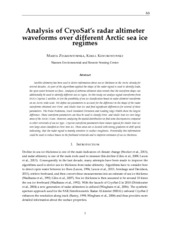Analysis of CryoSat’s radar altimeter waveforms over different Arctic sea ice regimes
Working paper

Åpne
Permanent lenke
https://hdl.handle.net/1956/9393Utgivelsesdato
2014-06-11Metadata
Vis full innførselSamlinger
- Geophysical Institute [1223]
Sammendrag
Satellite altimetry has been used to derive information about sea ice thickness in the Arctic already for several decades. As part of the algorithms applied the shape of the radar signal is used to identify leads, the open water between ice floes. Analysis of airborne altimeter data reveals that the waveform shape can additionally be used to identify different sea ice types. In this study we analyze signal waveforms from ESA’s CryoSat-2 satellite, to test the possibility of sea ice classification based on radar altimeter waveforms on an Arctic wide scale. We define six parameters to account for the difference in the shape of the radar waveforms obtained over First- and Multi-Year-Ice and find significant differences for several of these parameters. The Pulse Peakiness, Stack Standard Deviation and Leading Edge Width show the largest difference. These waveform parameters can thus be used to classify First- and Multi-Year-Ice over large areas of the Arctic Ocean. However, analyzing the spatial distribution we find some discrepancies compared to other retrievals of sea ice type. CryoSat waveform parameters have values typical for Multi-Year-Ice over large areas classified as First-Year-Ice. These areas are co-located with strong gradients in drift speed, indicating, that the radar signal is mainly sensitive to surface roughness. Potentially this information could be used to reduce biases in the freeboard retrievals and to improve estimates of sea ice thickness.